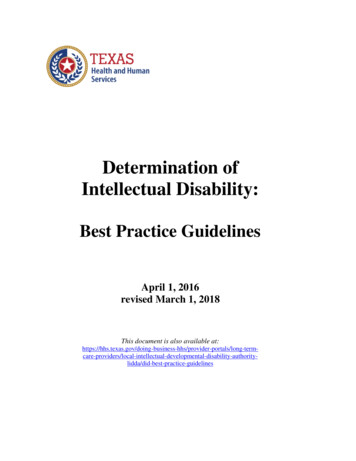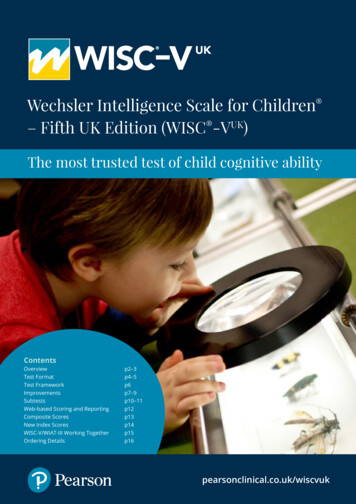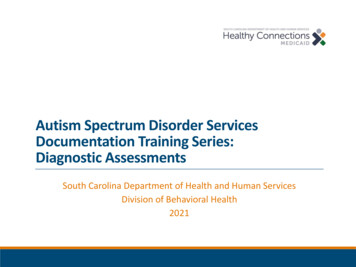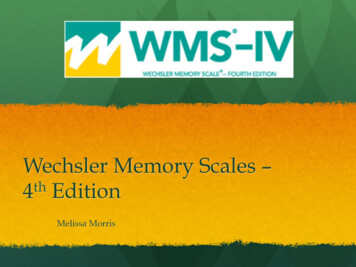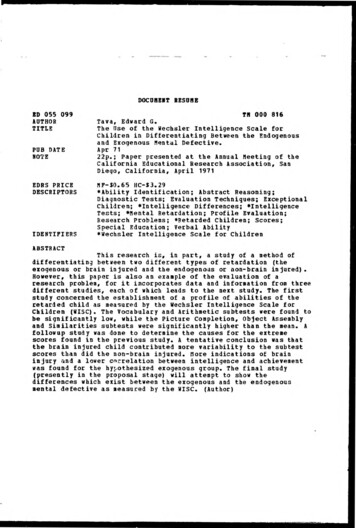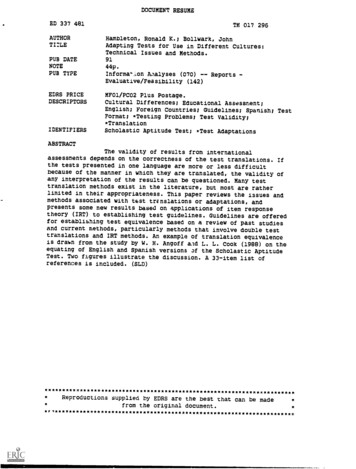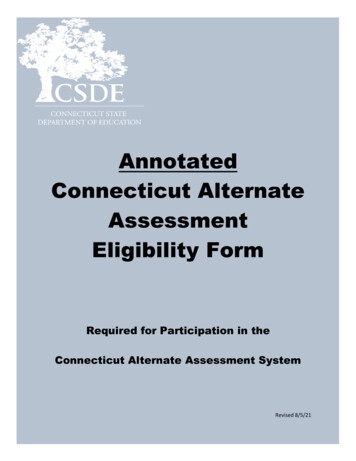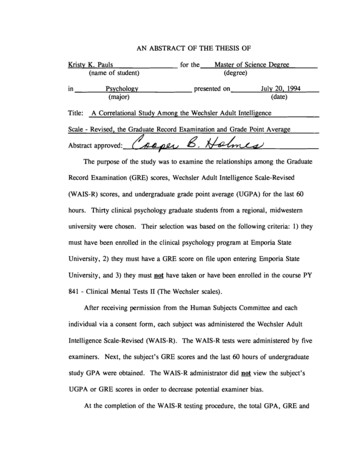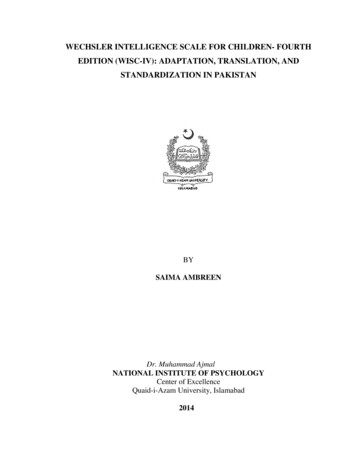
Transcription
WECHSLER INTELLIGENCE SCALE FOR CHILDREN- FOURTHEDITION (WISC-IV): ADAPTATION, TRANSLATION, ANDSTANDARDIZATION IN PAKISTANBYSAIMA AMBREENDr. Muhammad AjmalNATIONAL INSTITUTE OF PSYCHOLOGYCenter of ExcellenceQuaid-i-Azam University, Islamabad2014
WECHSLER INTELLIGENCE SCALE FOR CHILDREN- FOURTHEDITION (WISC-IV): ADAPTATION, TRANSLATION, ANDSTANDARDIZATION IN PAKISTANBySAIMA AMBREENA dissertation submitted toDr. Muhammad AjmalNATIONAL INSTITUTE OF PSYCHOLOGYCentre of ExcellenceQuaid-i-Azam University, Islamabad.In partial fulfillment of the requirement for the degree ofDOCTOR OF PHILOSOPHYINPSYCHOLOGY2014
LIST OF FOREIGN EVALUATORSThe Ph.D. dissertation on “Wechsler Intelligence Scale for Children- Fourth Edition(WISC-IV): Adaptation, Translation, and Standardization in Pakistan” prepared by MissSaima Ambreen has been evaluated by the following foreign examiners / evaluators:1. Prof. Dr. Ralph W. Hood, Department of Psychology, College of Arts andScience, The University of Tennessee at Chattanooga, USA.2. Prof. Thomas Holtgraves, Department of Psychological Sciences, College ofScience and Humanities, Ball State University, USA.3. Prof. Dr. Jennifer E. Lansford, Center for Child and Family Policy, the DukeUniversity, Durham, USA.
CERTIFICATEIt is certified that Ph.D. dissertation on “Wechsler Intelligence Scale for ChildrenFourth Edition (WISC-IV): Adaptation, Translation, and Standardization in Pakistan”prepared by Miss Saima Ambreen has been approved for submission.(Prof. Dr. Anila Kamal)Supervisor
AcknowledgementsAll praise to Allah Almighty, who bestowed upon me the rigor and courage tocomplete this research successfully. The present work can not be an individual effort.Many hands and many minds are behind it. Even if I miss the names of these individualsin the following lines, I owe them much for their help and concern.I am deeply grateful to my supervisor, Prof. Dr. Anila Kamal as her knowledge,technical expertise, and guidance enabled me to complete this challenging task. Sheremained a source of inspiration throughout the research and due to her brilliance andempirical approach; she will remain my role model for the rest of my life.I would also like to pay my gratitude to Pearson Assessment, USA for allowingme to work on Wechsler Intelligence Scale for Children (WISC-IV). An agreementbetween NSC Pearson Private Limited and NIP has made this research possible. Myspecial thanks to Angelina Mao and Dr. Joseph Michelle from NCS Pearson, India fortheir help, support, and guidance.I am indebted to Dr. Mah Nazir Riaz, Dean and Chairperson, Department ofPsychology, Frontier Women University, Peshawar for her expert review of adaptationsin verbal subtests. I am also much grateful to employees of National Language Authority,especially to Dr. Anwar Ahmed, Ex. Director General and Syed Sardar Ahmed Pirzada;their expert opinion helped me a lot in finalizing translations of various subtests.I would also like to thank Mr. Atif Mehmood Kiyani, Ex-Director General; Mr.Zafar Iqbal, Assistant Director Training, and other staff of Training section of Federali
Directorate of Education, Islamabad for allowing me to have test administrations in theirschools and colleges. Similarly, I am thankful to Maj. Gen. Zahid Parvez, Ex-DirectorWelfare and Education, and Col. Muhammad Zubair, Senior Manager Walfare- Collegesand Campuses, Fauji Foundation for permitting me to take data from their prestigiousinstitutes in the selected 10 districts of Pakistan. Special thanks to Principals and heads ofall schools or colleges from which I selected sample for test administration.I would like to thank all faculty members of NIP specially Dr. Rubina, Dr. Jamil,Dr. Moazama, and Dr. Humaira Jami for being part of my research work as members ofmy Expert Committee. I could not precede even step further without their precious timeand thoughtful suggestions during our long committee approaches. Many thanks to theNIP faculty members who were member of my translation team including Ms. Rabia, Ms.Shaista, Ms. Nelopher, Ms. Raiha, and Ms. Irum Naqvi.Much appreciations for the supporting staff of NIP including the computerlaboratory staff, library staff, and the administration staff who always provided me helpand required resources. My special thanks to Mr. Tahir Elahi for his continuousassistance in editing content of the manual and for his help in maintenance of myresearch data. Mr. Qayyum’s help in finding litrary material; and Mr. Khalid’s and Mr.Mohsin’s help in maintaining Ph.D. related paper work secured me from many duestresses.My team of test administrators Sufia, Amara, Mahpara, and Tabasum deservemuch more than a thanks for their help in test administrations. A very special thanks andii
appreciation for great support of my students cum team members Sara, Maria, Aneeqa,and Misbah throughout the research period.I have no words to express my gratitude for my family specially parents.Without their love, encouragement, and support I would not be able to achieve anythingin my life. They have shown great tolerance for my long working hours and long absencefrom home for various research works. The concern, support, and encouragement of mybrother, sister, and sister in law remained the source of motivation throughout myresearch. The love and attachment of my niece and nephews Linta, Rebal, and theyoungest Shayaan boosted my spirits at the time of extreme stress.I am thankful to my sincere friends, who supported me at every step of my work.Mr. Waseem Fayyaz with his scholarly discussions and confrontations always gave meguidance and motivation to achieve more. My hostel roommate and dearest friend SitwatAman with her immense tolerance for my studying habits was a big support for methroughout this period. My friends Mussarat, Nadia, and Fatima were always very helpfuland supportive. I would also like to thank Miss Saba Farooq for her continuous help,encouragement, and enjoyable company.I also owe deep appreciation for all the students who participated in the researchfor their time, feedback, and cooperation. Last but not the least; I wanted to thank all theparticipant teachers and members of my advisory panels, as without their insight andknowledge I would not be able to do this research.Saima Ambreeniii
AbstractThe present research was primarily aimed to adapt, translate, and standardizeWISC-IV for Pakistan. The research was conducted in collaboration with NCS PearsonPrivate Limited, India as part of a larger project aiming at standardization of WISC-IVfor South Asia. Research process was completed through three studies. Study-I wasconcerned with the adaptation and translation of WISC-IV and it was completed throughtwo phases. Phase I involved pre-testing of the original WISC-IV South Asia subtests(n 12). Its findings not only identified few items needing adaptation but also suggestedtranslation of instructions and/or item content of all subtests (including performancesubtests). Phase II was concerned with the steps involved in proper adaptation andtranslation of the WISC-IV subtests. It involved a priori procedures (judgmentalprocedures) for adaptation and translation of the subtests. These procedures includedmultiple-forward translation, committee approaches, and expert reviews. This processresulted in development of Urdu adaptation of WISC-IV in which child directedinstructions for all subtests and item content of all verbal subtests have been translatedinto Urdu along with various adaptive changes.Study II was aimed to evaluate the psychometric properties of the WISC-IVPAKthrough conduction of tryout I (n 33), tryout II (n 88), and tryout III (n 110). Initialtryout assessed functioning and comprehensibility of items through response frequencyand reliability analysis only. But other two tryouts involved Classical Test Theory (CTT)and Item Response Theory (IRT) based psychometric techniques to improve, itemreliability, item difficulty, item discrimination, and item fit. This detailed item analysisiv
involved item re-ordering of nine subtests and changes in item content and/or sampledresponses of few other subtests and resulted in finalization of WISC-IV PAK.The study III involved the standardization of the WISC-IV PAK and was completedthrough four phases. All the analyses conducted in this study are based on a normativesample of 800 children (50% girls) selected through following a stratified randomsampling design. The normative sample was stratified into 11 age groups, two gendergroups, five geographical regions, and three parental education levels. It was selectedfrom govt., semi-govt., and private schools and colleges situated in 10 districts ofPakistan. In the first phase of study III, subtests temporal stability and internalconsistency evidence was established. In the phase II a multi-model multi-trait matrixmethod was utilized to establish convergent and discriminant validity of WISC-IVPAK.The cross validation of WISC-IV factorial structure in Pakistan was also done during thisphase. Pakistani norms for WISC-IVPAKwere developed for 11 age groups of one yearranging from 6 to 16 years and 11 months in the phase III of the standardization study.Two types of norms including standard score norms (scaled scores and composite scores)and test-age equivalent norms were derived. Comparison of WISC-IVPAKcompositescores by using Pakistani and UK norms was also conducted in this phase. In the lastphase of study III influence of variables like age, gender, geographical region, andparental education level on children’s intelligence level was explored. This concluded theefforts to provide a reliable and well-standardized tool to measure intelligence ofPakistani children.v
List of TablesTable 1Comparison of Mean Raw Scores of Children on Digit Span inEnglish and Urdu (N 20)Table 294Psychometric Properties and Score Distribution of AdaptedWISC-IV Subtests (N 88)Table 3108Tests of Normality for Similarities, Vocabulary, Letter-NumberSequencing, and Information Subtests (N 88)Table 4Psychometric Properties and Score Distribution for the ThreeAge Groups on Adapted WISC-IV Subtests (N 88)Table 5111Reliability Coefficients of the WISC-IV Subtests for the FullSample and for the Three Age GroupsTable 6110113Item Difficulties (MN) and Corrected Item-total CorrelationCoefficients (PB) of the Block Design Subtest Items for all theCases and for the Three Age GroupsTable 7Misfit Indices for items of Block Design Subtest of AdaptedWISC-IV (N 88)Table 8119Item Difficulties (pv) and Corrected Item-total CorrelationCoefficients (PB) of the Similarities Subtest Items for all theCases and for the Three Age GroupsTable 9118Misfit Indices for items of Similarities Subtest of Adaptedvi121
WISC-IV (N 88)122Table 10 Item Difficulties (MN) and Corrected Item-total CorrelationCoefficients (PB) of the Digit-Span (Backward) Subtest Items124for all the Cases and for the Three Age GroupsTable 11 Item Difficulties (MN) and Corrected Item-total Correlation124Coefficients (PB) of the Digit-Span (Forward) Subtest Items forall the Cases and for the Three Age GroupsTable 12 Item Difficulties (MN) and Corrected Item-total CorrelationCoefficients (PB) of the Block Design Subtest Items for all the126Cases and for the Three Age GroupsTable 13 Misfit Indices for items of Picture Concept Subtest of AdaptedWISC-IV (N 88)128Table 14 Item Difficulties (pv) and Corrected Item-total CorrelationCoefficients (PB) of the Vocabulary Subtest Items for all the130Cases and for the Three Age GroupsTable 15 Misfit Indices for items of Vocabulary Subtest of AdaptedWISC-IV (N 88)131Table 16 Item Difficulties (MN) and Corrected Item-total CorrelationCoefficients (PB) of the Letter-Number-Sequencing Subtest134Items for all the Cases and for the Three Age GroupsTable 17 Misfit Indices for items of Letter-Number-Sequencing Subtestof Adapted WISC-IV (N 88)135vii
Table 18 Item Difficulties (pv) and Corrected Item-total CorrelationCoefficients (PB) of the Comprehension Subtest Items for all136the Cases and for the Three Age GroupsTable 19 Misfit Indices for items of Comprehension Subtest of AdaptedWISC-IV (N 88)137Table 20 Item Difficulties (MN) and Corrected Item-total CorrelationCoefficients (PB) of the Block Design Subtest Items for all the138Cases and for the Three Age GroupsTable 21 Misfit Indices for items of Matrix Reasoning Subtest of AdaptedWISC-IV (N 88)140Table 22 Item Difficulties (MN) and Corrected Item-total CorrelationCoefficients (PB) of the Picture Completion Subtest Items for142all the Cases and for the Three Age GroupsTable 23 Misfit Indices for items of Picture Completion Subtest ofAdapted WISC-IV (N 88)144Table 24 Item Difficulties (MN) and Corrected Item-total CorrelationCoefficients (PB) of the Information Subtest Items for all the146Cases and for the Three Age GroupsTable 25 Misfit Indices for items of Information Subtest of AdaptedWISC-IV (N 88)148Table 26 Item Difficulties (MN) and Corrected Item-total CorrelationCoefficients (PB) of the Arithmetic Subtest Items for all theviii
Cases and for the Three Age Groups150Table 27 Misfit Indices for items of Arithmetic Subtest of AdaptedWISC-IV (N 88)151Table 28 Item Difficulties (MN) and Corrected Item-total CorrelationCoefficients (PB) of the Word Reasoning Subtest Items for all153the Cases and for the Three Age GroupsTable 29 Misfit Indices for items of Word Reasoning Subtest of AdaptedWISC-IV (N 88)154Table 30 Psychometric Properties of the Score Distribution on AdaptedWISC-IV Subtests (N 88)158Table 31 Reliability Coefficients of the WISC-IV Subtests for the FullSample and for the Three Age Groups159Table 32 Item Difficulties (pv) and Corrected Item-total CorrelationCoefficients (PB) of the Similarities Subtest Items for all the161Cases (N 110) and for the Age Group of 6-8 yearsTable 33 Item Difficulties (pv) and Corrected Item-total CorrelationCoefficients (PB) of the Vocabulary Subtest Items for all the163Cases (N 110) and for the Age Group of 6-8 years (N 30)Table 34 Item Difficulties (MN) and Corrected Item-total CorrelationCoefficients (PB) of the Information Subtest Items for all theCases (N 110) and for the Age Group of 6-8 years (N 30)ix166
Table 35 Reliability Coefficients of Re-ordered WISC-IV PAK Subtests (N 50)168Table 36 Description of Characteristics of Normative Sample (N 800)176Table 37 Stability Coefficients of all Subtests of WISC-IV PAK along withMeans and Standard Deviations for two testing sessions (N 34)179Table 38 Alpha Reliability Coefficients of the WISC-IV PAK Subtests andIndex Scores for the Full Sample and for the Three Age Groups183Table 39 Item-total Correlations of Constituent Subtests of VerbalComprehension Index (VCI) of WISC-IV PAK (N 800)185Table 40 Item-total Correlations of Constituent Subtests of PerceptualReasoning Index (PRI) of WISC-IV PAK (N 800)187Table 41 Item-total Correlations of Constituent Subtests of WorkingMemory Index (WMI) of WISC-IV PAK (N 800)189Table 42 Intercorrelation Matrix of the Raw Scores for Subtests andScales/Indexes on WISC-IV PAK (N 800)193Table 43 Goodness-of-Fit Statistics for Confirmatory Factor Analysis ofCore Subtests for Full sample and for the Three Age Groups198Table 44 Sources of Variance for each Core Subtest in the Four-FactorModel of WISC-IV PAK (N 800)x201
Table 45 Goodness-of-Fit Statistics for Confirmatory Factor Analysis ofAll Subtests for Full sample and for the Three Age Groups204Table 46 Sources of Variance for each Subtest in the Four-Factor Modelof WISC-IV PAK (N 800)207Table 47 Goodness-of-Fit Statistics for Higher-Order ConfirmatoryFactor Analysis of Core Subtests and of All Subtests for Full210sample (N 800)Table 48 Sources of Variance for each Subtest in the Four-Factor Modelof WISC-IV PAK Core Subtests and All Subtests (N 800)214Table 49 Means and Standard Deviations of the Scaled Scores on WISCIV PAK Subtests for the Normative Sample (N 800)218Table 50 Means and Standard Deviations of the Scaled Scores on WISCIV PAK Subtests for All the Eleven Age Groups (N 800)220Table 51 Mean and Standard Deviations of Composite Scores for WISCIV PAK Indices and Full Scale IQ (N 800)222Table 52 Standard Error of Measurement and Confidence Interval forComposite Scores223Table 53 Differences of means and Standard Deviations of Four IndexBased Composite Scores and FSIQ when Pakistan and UKNorms are Used (N 800)xi225
Table 54 Test- Age Equivalents of Total Raw Scores for WISC-IV PAKSubtests227Table 55 Differences in Means and Standard Deviations of FSIQ of the11 Age Groups (N 800)229xii
List of AppendicesAppendix AInformed Consent FormAppendix B1WISC-IV Record Form (Original) in EnglishAppendix B2WISC-IV Response Booklet 1Appendix B3WISC-IV Response Booklet 2Appendix C1Initial List of Urdu Replacement Words for Vocabulary SubtestAppendix C2Final List of Urdu Replacement Words for Vocabulary SubtestAppendix D1List of Items suggested for Adaptation along with the Replaced ItemsAppendix D2List of Changes in Content of WISC-IV Items or Sampled Responsesbased on Pre-testing/Expert Opinion)Appendix E1Record Form-UrduAppendix E2Response Booklet 1 in UrduAppendix F1List of Randomly Selected Educational Institutes under AdministrativeControl of Federal Directorate of Education, PakistanAppendix F2Permission Letter from Federal Directorate of Education, IslamabadAppendix GBox plots of all Subtests of WISC-IV PAK (G1 – G15)Appendix HSchematic Plots of Seven WISC-IV PAK Subtests (H1 – H7)Appendix ILists of Re-ordered Items of WISC-IV PAK Subtests along with DifficultyIndex and Original Order (after Tryout II)Appendix J1List of Added Items for Tryout-IIIAppendix J2Record Form-Urdu for Tryout-IIIAppendix KBox Plots of Similarities, Vocabulary, and Information Subtests ofWISC-IV PAK (K1 – K3 after Tryout III)xiii
Appendix LRecord Form (Urdu)Appendix MPakistan’s Population by Province/Region since 1951Appendix NList of Selected Schools and Colleges from 9 Randomly SelectedDistricts of Pakistan along with the Permission Letter for DataCollectionAppendix O Item-total Correlations of Supplemental Subtests of WISC-IV PAKAppendix PFigural Presentation of Four-Factor Structure of WISC-IV CoreSubtests for the Three Age Groups (P1 – P3)Appendix Q Figural Presentation of Four-Factor Structure of WISC-IV AllSubtestsfor the Three Age Groups (Q1 –Q3)Appendix R Scaled Score Equivalents of the Total Raw Scores on WISC-IVSubtest’s, by Age Group (R1 & R11)Appendix SComposite Scores for the Sum of Scaled ScoresxivPAK
List of FiguresFigure 1Pie Chart for Percentages of Normative Sample taken from thefive Geographical RegionsFigure 2173Bar Chart for Comparison of Normative Sample PopulationCoverage and 1998 Census Population CoverageFigure 3Figural Presentation of Four-Factor Structure of WISC-IV174PAKCore SubtestsFigure 4Figural Presentation of Four-Factor Structure of All WISC-IVPAKFigure 5200Subtests206Figural Presentation of Higher-Order Four-Factor Structure ofWISC-IV PAK Core SubtestsFigure 6212Figural Presentation of Higher -Order Four-Factor Structure ofAll WISC-IV PAK Subtests213xv
INTRODUCTION
Chapter IIntroductionIntelligence and Intelligence Quotient (IQ) are among the most importantconcepts of psychology, yet these are also the most complex and sometimes disputatiousissues. Researchers focus more on psychometric intelligence because it is considered asgeneral academic aptitude and have strong educational implications (Storfer, 1990).Intelligence testing with its strong history and ever growing scope can be regarded asmother of psychometrics. From the last nearly one hundred years, intelligence testing hasgained much attention in psychological research, clinical practice, and psychoeducational assessment throughout the world. Even in developing countries like Pakistan,growing progress in research, education, and mental health services is creating increasedneed for intelligence testing.In Pakistan, Armed forces, Federal Public Service Commission, and ProvincialPublic Service Commissions are using many intelligence tests. But most of these tests areused and constructed for the specific purpose of personnel selection, so they may havepsychometric limitations when used for other purposes. In clinical and educationalsettings few popular standardized intelligence tests such as Raven Progressive Matrices(Raven, 1936) and Otis-Lennon School Ability Test (Otis & Lennon, 1979) are also inuse (as cited in Hashmi, 2000). These well-constructed standardized tests are of limiteduse in Pakistan due to differences from culture in which they were developed. Forexample, being less familiar task a test having only matrices can not effectively gaugeintelligence in Pakistan. Items on an intelligence test mirror the culture of the society in1
which the test is developed and used. So great care is required while using theseotherwise psychometrically strong tests in cultures that differ from the culture in whichthey were developed. This problem of cultural relevance can be resolved by properadaptation and translation of such tests for the specific culture in which it is to be used.So present study is conducted to adapt, translate, and standardize the WechslerIntelligence Scale for Children, Fourth Edition (WISC-IV; Wechsler, 2004) for Pakistanipopulation.IntelligenceIntelligence has been a topic of concern and curiosity among philosophers,employers, educators, psychologists, anthropologists, and lay people that extends backhundreds of years (Cianciolo & Sternberg, 2004). But attempts to develop a precise butcomprehensive definition of intelligence have been fraught with difficulty and debate dueto its abstract and metaphorical nature. It is a general label for a group of internalprocesses that are inferred from more observable behaviors and responses and has beenconsidered as a multifaceted faculty that displays itself in various ways throughout thelife.Numerous attempts have been made to define intelligence, but the first people toponder the nature of intelligence were not psychologists or educators, but werephilosophers. The ancient Greek philosopher Plato has resembled intelligence to waxblocks of different size, hardness, moistness, and purity. To him a person who is sufferingfrom intellectual deficits would have an overly hard or soft and muddy wax block.Thomas Aquinas believed that intelligent people have more complete and universal2
comprehension skills than less intelligent people. While, eighteenth century philosopherImmanuel Kant was of the view that intelligence has many kinds or facets, andindividuals clearly differ in the degree to which they possess them (as cited in Cianciolo& Sternberg, 2004). Galton (1869, 1883) saw intelligence as the underlying mentalstrength (energy) and believed it to have a physical or sensory-motor attribute (as cited inMahmood, 1991), while Binet believed that intelligence includes abilities like reasoning,judgment, memory, and abstract thinking but emphasized judgment as the fundamentalfaculty (Binet & Simmon, 1916). Similarly, Wechsler in 1958 conceptualized intelligenceas global capacity of the individual to act purposefully, to think rationally, and to dealeffectively with his environment (as cited in Marnat, 1990).Cohen and Swerdlik (2005) has discussed four major approaches to studyintelligence including the developmental or Piagetian approach, the neurologicalbiological approach, the cognitive or information processing approach, and thepsychometric or factor-analytical approach. These approaches along with their relevanttheories can be best understood on the basis of seven metaphors of mind that have guidedscholarly exploration into the nature of intelligence.Geographic Metaphor. Theories of intelligence that correspond to a geographicmetaphor represent an attempt to develop a map for the human mind. These mental mapsdescribe structure of mind and underlying intellectual abilities. Modern geographictheories of intelligence are devoted to identify the basic intellectual abilities, calledability factors, that supposedly underlie the range of intelligent acts and they also assumethat people differ in level to which they possess these abilities/set of abilities or factors(as cited in Cianciolo & Sternberg, 2004).3
Factor-analytical Theories of Intelligence. Statistically based factor-analyticalresearch has resulted in emergence of various theories of intelligence since long. Thesegeographic theories mainly differ in number of factors and in the particular kind ofidentified factors.Among many presented theories of intelligence that were based on factor analysisis the Two-Factor theory of Intelligence formulated by Spearman in 1927. He proposedthe existence of a general intellectual ability factor ‘g’ and specific ability factor ‘s’ inintelligence. He was primarily interested in what is common among various intellectualabilities rather than their differences. Criticisms of the two-factor theory have not beenlacking, and many alternative theories have been proposed. Thorndike, for example,formulated a theory that viewed intelligence as a composite of many different abilitiesinterconnecting in the brain. He proposed three kinds of intelligence labeled as social,concrete, and abstract. Similarly, Multiple-Factor theory was given by Thurston in 1938.He conceived intelligence as consisting of seven ‘primary abilities’ including VerbalMeaning, Number Facility, Inductive Reasoning, Perceptual Speed, Spatial Relations,Memory, and Verbal Fluency. The theory of Structure-of-intellect was proposed byGuilford (1967). He explained mental activities by deemphasizing the ‘g’ factor. In hismodel there are not less than 120 distinctive abilities based on five kinds of operations(cognition, memory, divergent thinking, convergent thinking, and evaluation), four typesof content (figural, symbolic, semantic, and behavioral), and six products (units, classes,relations, systems, transformations and implications). Later revisions of Guilford’s modelfeatured 150 and even up to 180 distinct abilities (as cited in Cohen & Swerdlik, 2005).4
Factor-analytical Theories impelling Intelligence Testing. From the end of 20thcentury, an intelligence theory that was proposed by Cattell (1971) has gained growingattention from test constructors and test users. The theory postulated the existence of twomajor types of cognitive abilities: crystallized intelligence, Gc (includes acquired skillsand knowledge that is cultural-specific and its application such as vocabulary) and fluidintelligence, Gf (includes non-verbal, relatively cultural-free knowledge such as memoryfor digits). Modifying Cattell’s theory, Horn (1991) gave the idea add several factors toCattell’s two factors like visual processing (Gv), auditory processing (Ga), quantitativeprocessing (Gq), speed of processing (Gs), facility with reading and writing (Grw), shortterm memory (Gsm), long-term storage and retrieval (Glr). He agreed with the existenceof crystallized and fluid intelligence but differed with Cattell in suggesting that both thesefactors are learned and are also based on heredity. He says that Gf is based on casuallearning, while Gc is based on cultural and school type learning.Carroll (1997) presented his Three-Stratum Theory of cognitive abilities based onthe factor-analytical studies. On top stratum of Carroll’s model is ‘g’ or generalintelligence; whereas, the second stratum consists of eight abilities or processes: FluidIntelligence (Gf), Crystallized Intelligence (Gc), General Memory and Learning (Y),Broad Visual Perception (V), Broad Auditory Perception (U), Broad Retrieval Capacity(R), Broad Cognitive Speediness (S), and Processing/ Decision Speed (T). While, thethird stratum is composed of several ‘level factors’ and ‘speed factors’, each varies on thebases of the second level stratum to which they are associated. So, Carroll’s model ishierarchical in nature (as cited in Cohen & Swerdlik, 2005).5
The Cattell-Horn and Carroll models have various similarities with each other.Beside the differences including the presence of a general ‘g’ factor, an integration ofthese two models was proposed by McGrew (1997). The result was CHC model (CattellHorn-Carroll model). This model has greatly influenced the recent test developmentincluding the development and interpretation of fourth edition of WISC (Wechsler, 2003)and fifth edition of Stanford Binet test (SB5; Roid, 2003).The Cattell-Horn-Carroll (CHC) model was subsequently modified on the basis offurther factor-analytical work by McGrew and Flanagan in 1998. In its recent form theCHC model propose to have ten “broad-stratum” abilities and more than seventy“narrow-stratum” abilities, each of the broad-stratum ability has linking with two or morenarrow-stratum abilities. The ten broad-stratum abilities are: Fluid Intelligence (Gf),Crystallized Intelligence (Gc), Quantitative Knowledge (Gq), Reading/ Writing Ability(Grw), Short-Term Memory (Gsm), Visual Processing (Gv), Auditory Processing (Ga),Long-Term Storage and Retrieval (Glr), Processing Speed (Gs), and Decision/ReactionTime or Speed (Gt). This model gives no apparent place to the general intellectual abilityfactor ‘g’ but this does not mean that the integrated model does not subscribe to aseparate general human ability or that ‘g’ does not exist. Rather, it was omitted as it haslittle practical relevance in psycho-educational assessment and the model was proposedin an effort to improve the practice of psycho-educational assessment (McGrew &Flanagan as cited in Cohen & Swerdlik, 2005).Geographic metaphor based theories explain the abilities underlying intelligencewell that led to their measurement but they do not clarify how intelligence or intellectualabilities work, or how mental processes involved in these abilities work.6
Computational Metaphor. These theories of intellig
method was utilized to establish convergent and discriminant validity of WISC-IV PAK. The cross validation of WISC-IV factorial structure in Pakistan was also done during this phase. Pakistani norms for WISC-IV PAK were developed for 11 age groups of one year ranging from 6 to 16 years and 11 months in the phase III of the standardization study.

